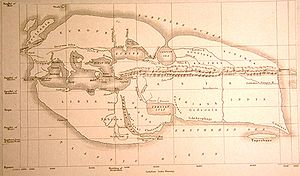Ariana
Ariana, the Latinized form of (Greek: ἡ 'Αρειανή/Arianē),
inhabitants: Ariani (Greek: Αρειανοί/Arianoi), was a region of
the eastern countries of ancient Persia, next to the Indian subcontinent,
including Afghanistan, most of Tajikistan, east Iran, south Turkmenistan, south
Uzbekistan and west Pakistan. At various times, the region was in possession of
the Persians, the Macedonians, and partly the Indians. Its exact limits are
laid down with little accuracy in classical sources, and it seems to have been
often confused (as in Pliny, Naturalis Historia, book vi, page 23) with
the small province of Aria.

|
| 19th century reconstruction of a map of the world by Eratosthenes, c.194 BC. |
As a geographical term, Ariana was introduced by Eratosthenes,
and as such its borders were defined by the Indus river in the east, the sea in
the south, a line from Carmania to the Caspian Gates in the west, and the
so-called Taurus Mountains in the north. This large region included almost all
of the countries east of Media and ancient Persia, including south of the great
mountain ranges up to the deserts of Gedrosia and Carmania, i.e. the provinces
of Carmania, Gedrosia, Drangiana, Arachosia, Aria, the Paropamisadae; also Bactria
was reckoned to Ariana and was called "the ornament of Ariana as a
whole" by Apollodorus of Artemita. After having described the boundaries
of Ariana, Strabo writes that the name Αρειανή could also be extended to part
of the Persians and the Medes and also northwards to the Bactrians and the Sogdians.
A detailed description of that region is to be found in Strabo's Geographica,
Book XV – "Persia, Ariana, the Indian subcontinent", chapter 2,
sections 1-9.
Rüdiger Schmitt, the German
scholar of Iranian Studies, writes in the Encyclopædia Iranica:
Eratosthenes’ use
of this term (followed by Diodorus 2.37.6) is obviously due to a mistake,
since, firstly, not all inhabitants of these lands belonged to the same tribe
and, secondly, the term "Aryan" originally was an ethnical one and
only later a political one as the name of the Iranian empire (for all Indians
and Iranians designated themselves as "Aryan"), thus comprising still
other Iranian tribes outside of Ariana proper, like Medes, Persians or Sogdians
(so possibly in Diodorus 1.94.2, where Zarathushtra is said to have preached Ahura
Mazdā's laws "among the Arianoi").
—R. Schmitt, 1986
The Greek term is based upon Old Iranian Āryana- (Avestan: Airiiana-,
esp. in Airiianəm vaēǰō, the name of the Aryans’ mother country, whose
localization is disputed), which is connected with the Avestan term Airya-,
the Old Persian term Ariya- and the Sanskrit term Arya-,
"noble", "excellent" and "honourable" (esp. in Āryāvarta,
Sanskrit: आर्यावर्त, "abode
of
the Aryans").
|
 |
|
|
 |
|
|
 |
|
|
|

